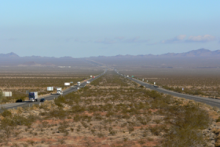Article
A large, fast U.S. road system that crosses state boundaries. The term refers specifically to express, or high-speed roads, constructed as a result of the Federal Aid Highway Act of 1956, a law initiated by President Dwight D. Eisenhower, which authorized the building of a network of highways spanning 41,000 miles across the nation. Eisenhower, who was a leading army general before becoming president of the U.S., was determined to build such a network primarily for Cold War national security purposes. Cross-country expressways, he reasoned, would enable efficient transportation of military weapons and supplies, fast troop deployment, and easy evacuation of big cities should the need arise. The interstate system served other purposes as well, such as relieving traffic congestion and encouraging motor vehicle use and consumption during the post-World War Two boom of suburban development and associated conspicuous consumption associated with leisure time and travel in the U.S. Under the 1956 act, the Federal government was responsible for paying 90 percent of the cost of the project, with individual states contributing only 10 percent. The money for the construction work came mostly from an increased federal tax on gasoline. According to the terms of the act, the new high-speed freeways were designed to have at least four lanes, no traffic lights, and controlled access through overpasses and underpasses, rather than intersections.
The interstate system has had long lasting effects on the American landscape and lifestyle. It promoted automobile and gasoline consumption, and, despite the conveniences it offered, had many undesirable consequences. In many areas throughout the country, the construction of interstate freeways has raised environmental and social concerns. In the 1960s, activist groups organized in various large cities, after it was clear that the construction of freeways damaged neighborhoods, destroyed homes, displaced people, and severed communities. Protesting was successful in many cases, and activists managed to prevent interstates from going through a number of big cities such as San Francisco, New York City, Baltimore, New Orleans, and Washington D.C.
"The four lanes of separated directional travel of Interstate 40, looking east from Exit 100 in southern California, January 20, 2007" by Stan Shebs is licensed under CC BY-SA.
Manuscripts
References
History Online
2015 The Interstate Highway System.
http://www.history.com/topics/interstate-highway-system, accessed February 12, 2015.
Lewis, David L.
1985 The Interstate Highway System: Issues and Options. Washington, D.C.: Congress of
the U.S., Congressional Budget Office.
United States Federal Highway Administration
1993 Eisenhower Interstate System. Washington, D.C.: U.S. Department of Transportation,
Federal Highway Administration.

